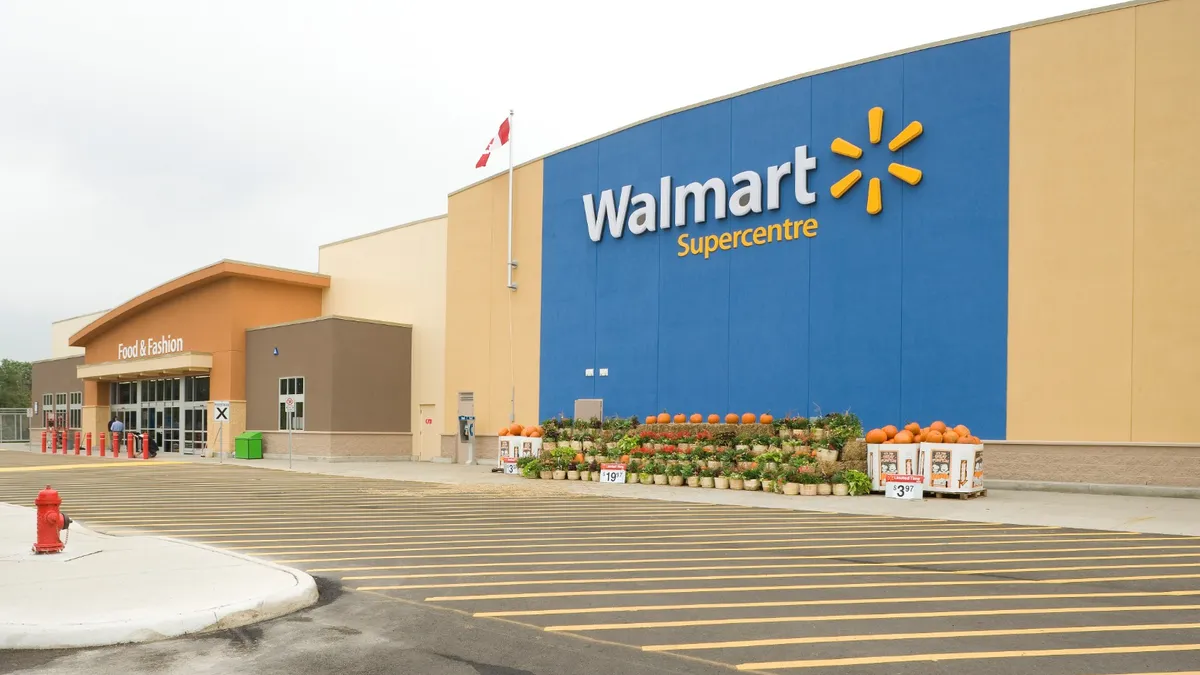Dive Brief:
- The battle of the retail giants has only intensified this year. A new report from Moody's analysts led by Charlie O'Shea looks at the fallout and possible outcomes as Amazon and Walmart throw competitive jabs and make forays onto turf long dominated by the other.
- The analysts noted a "delivery arms race" that is "escalating," with Amazon and Walmart each announcing various takes on next-day shipping within a month of each other this spring. They also posited that Walmart could make gains in an area long dominated by Amazon: third-party sellers. Helping Walmart on this front are its physical stores, which offer space to outsiders, and something it doesn't have: Amazon's propensity for developing competing brands.
- Food is an area where Amazon has major ambitions and Walmart has long dominated, and it may continue to do so. O'Shea and his team wrote that "Amazon is still a Lilliputian compared to Walmart's Gulliver," with Amazon's estimated $20 billion in grocery revenue just a fraction of Walmart's $270 billion. "In other words, Walmart's lead in food over Amazon is as insurmountable as Amazon's online lead over Walmart," the analysts wrote.
Dive Insight:
The general merchandising giants — namely Walmart and Target — have been winners so far this year in a bruising retail market even as they compete against an ever-growing Amazon, which has the advantage of largely "profit-agnostic" investors, in the words of O'Shea.
In the first quarter, Walmart and Target both made gains in online sales as well as in their stores, as the differences between store sales and online sales get murkier. Both have relied on their store base as an advantage, which can act as delivery nodes and pickup locations.
Meanwhile, Amazon's physical same-store sales — consisting mainly of its Whole Foods locations, rose just 1% (though that figure is 6% with digital sales included). At 16.6%, Amazon's sales growth in North America in Q1 would have been solid for any normal retailer. But it represented a significant slowdown from growth of more than 46% a year ago.
"For a long time, Amazon was the only real player in the game, now it is having to share the field with an increasing lineup of formidable rivals," GlobalData Retail Managing Director Neil Saunders commented in April, referring to e-commerce.
And as other retailers catch up online, one of Amazon's longstanding ambitions — to become a force as a food retailer — has major obstacles. Chief among them are Walmart and the costs of building stores. With customers still favoring physical grocery stores, Amazon "will need to significantly expand its store base and distribution capability" if it wants to be "anything more than a niche food retailer," O'Shea and his team wrote. "Walmart, meanwhile, continues to leverage its massive store base and top-notch supply chain, which supports its over 5,300 US stores," they added.
What Amazon does have, though, is a digital ecosystem that includes devices, media content and more recently advertising, as well as a hugely profitable cloud services business that helps support the company financially.
While the titans of retail face off, life for everybody else risks getting more difficult. Retailers with shakier finances "have ever-diminishing control over their destiny," the Moody's team wrote. Those in differentiated product categories (like dollar stores) or perfected business models (such as Best Buy and Costco) are safer, the analysts added. "But for the many other retailers, the best strategy could be to try and stay out of the way of this bigger battle."














